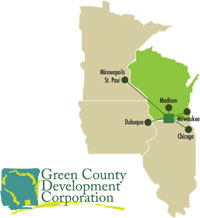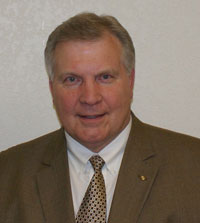The current labor situation in the United States is a top-of-mind issue for many. While the buzz remains on unemployment, which held at 9.7 percent at the end of March 2010, nonfarm payroll employment increased by 162,000 in March and temporary help services and health care continued to add jobs. Employment in federal government also rose, reflecting the hiring of temporary workers for Census 2010.
Nevertheless, these Department of Labor statistics only portray the macro employment picture. With workforce availability and composition being a critical factor in any corporate development executive’s short list of location evaluation criteria, it’s helpful to get an inside look at the highlights of the labor forces in select areas you may be considering. In this issue’s Community Progress Report, we examine the unique attributes of the workforces in the following communities.
Green County, Wisconsin Green County, Wisconsin, is well-positioned to attract quality employers and employees. It is located in southern Wisconsin, on the Illinois border. Major metro areas within a two-hour drive include Madison, Wisconsin; Rockford, Illinois; Dubuque, Iowa; and Chicago, Illinois.
Green County, Wisconsin, is well-positioned to attract quality employers and employees. It is located in southern Wisconsin, on the Illinois border. Major metro areas within a two-hour drive include Madison, Wisconsin; Rockford, Illinois; Dubuque, Iowa; and Chicago, Illinois.
The workforce attracted to Green County is well known for its high productivity. Employers in the area consistently report that their employees play an integral role in their ability to be successful.
“Kuhn North America relies on the contributions of its employees to remain competitive and to continue our growth. The skilled and dedicated workforce in Green County is one key factor that has encouraged us to make significant investments in our Brodhead, Wisconsin, facility, which has become the North American headquarters for our international company,” stated Thierry Krier, president, Kuhn North America, Inc.
Nonetheless, the recession has had a significant impact on employment and employment rates. Unemployment rates had been near four percent for the 11 years before the current recession. But since early 2010, rates continue to hover just under 10 percent, with over 1,950 persons unemployed in Green County, and nearly 25,000 unemployed in the region surrounding Green County. Couple the unemployed with the training capabilities of Blackhawk Technical College-Monroe, Wisconsin, and expanding businesses wishing to locate in an area with a high-quality, available workforce will find a great opportunity in Green County.
Grand Island, Nebraska Midwesterners are renowned as high-quality, productive employees. Those in Grand Island, Nebraska, are no exception. Many in the labor force grew up in the area and with a superior education and training system in place, they and the rest of the workforce have the opportunity to expand their knowledge and refine their skills.
Midwesterners are renowned as high-quality, productive employees. Those in Grand Island, Nebraska, are no exception. Many in the labor force grew up in the area and with a superior education and training system in place, they and the rest of the workforce have the opportunity to expand their knowledge and refine their skills.
Nebraska is a right-to-work state. Combined with its low worker's compensation premium rates, Industrial Espionage Act and state statutes that control mass picketing and the secondary boycott, it provides an attractive labor climate to business and industry. Nebraska also has one of the lowest percentages in the United States of lost working time due to labor management disputes.
Grand Island’s largest private industry sector is Trade, Transportation and Utilities, with Manufacturing second. The Trade, Transportation and Utilities sector alone constitutes one-quarter of the area’s employment, increasing by 14.3 percent between 2001 and 2007.
The labor force continues to grow in Grand Island, increasing 8.5 percent between 2000 and 2008, above the statewide growth of 4.8 percent. Contributing to the labor force is a large number of commuters. The Grand Island unemployment rate was generally below the statewide level between 2000 and 2006, and is still significantly below the national level and slightly below the statewide level.
Langlade County, Wisconsin The skilled workforce in Langlade County, Wisconsin, which is nestled in the heart of Wisconsin’s Northwood and home to approximately 20,000 residents, is a big draw to many businesses. These businesses mainly focus on manufacturing, agriculture, timber and tourism.
The skilled workforce in Langlade County, Wisconsin, which is nestled in the heart of Wisconsin’s Northwood and home to approximately 20,000 residents, is a big draw to many businesses. These businesses mainly focus on manufacturing, agriculture, timber and tourism.
A unique aspect of area businesses is their collective effort to constantly equip their incumbent employees with the means to work efficiently together to move forward. By collaborating with the local technical college system, Northcentral Technical College-Antigo (NTC), five area manufacturers are working toward this goal. By banding together to provide training for their employees, the companies in this five-business consortium are better positioned for growth in the region.
This is being achieved through the Workforce Advancement Training (WAT) grant. The WAT grant is designed not only to offer training opportunities, but to also improve Wisconsin businesses’ productivity and competitiveness, and to augment the state’s economic base by expanding NTC’s training services to businesses and industry.
The mechanics of the WAT grant are quite simple: monies from the grant are used to offset the cost of classes offered through NTC, ultimately saving the businesses training costs. The courses currently offered are centered on Critical Core Manufacturing, Overview of Business Basics, Leadership Development and Project Management.
Martinsville-Henry County, Virginia Located on the southern border of Virginia, Martinsville-Henry County is within a 50-mile radius of more than 850,000 people in the workforce. Within Martinsville-Henry County there are more than 5,000 available skilled workers who possess a strong work ethic that is rooted in decades of manufacturing. Nevertheless, manufacturing wages in the county average only $33,260 per year — 39 percent lower than the national average. In addition, as part of a right-to-work state, the area has one of the lowest unionization rates in the country – at under one percent.
Located on the southern border of Virginia, Martinsville-Henry County is within a 50-mile radius of more than 850,000 people in the workforce. Within Martinsville-Henry County there are more than 5,000 available skilled workers who possess a strong work ethic that is rooted in decades of manufacturing. Nevertheless, manufacturing wages in the county average only $33,260 per year — 39 percent lower than the national average. In addition, as part of a right-to-work state, the area has one of the lowest unionization rates in the country – at under one percent.
Martinsville-Henry County has a long-standing textile and furniture history, and well over 50 percent of the workforce is trained with manufacturing skills. Workers in the community are skilled as machine operators; maintenance technicians; CNC technicians; customer service representatives; accounting personnel; and transportation and material moving operators.
In addition to its roots in furniture and textile manufacturing, Martinsville-Henry County has undergone a transformation of its economy over the past 10 years. It is now home to plastics and polymer processors, logistics and distribution companies, food processors and more.
The strong work ethic in Martinsville-Henry County has contributed to many companies choosing to stay in the area and expand, as attested by West Window Corporation. “The key to West Window’s long success is the loyal and dedicated employees,” said Don Hodges of West Window Corporation. “You won’t find better employees than those in Martinsville-Henry County.”
Maumelle, Arkansas Named the fastest-growing city in Arkansas in 2009, Maumelle, Arkansas, has a key advantage in drawing employees from a large labor pool: it is located in central Arkansas and is part of the Little Rock Metro area. In addition, Maumelle residents have one of the highest education levels in the state. With numerous institutions of higher learning within a 25-mile radius, employers have access to an educated workforce as well as workforce training programs that offer customized training designed to help businesses stay competitive in today’s global marketplace. One such program for eligible businesses is the Business and Industry Training Program (BITP) provided by the Arkansas Economic Development Commission (AEDC). This program provides pre-employment training for Arkansas workers to meet necessary skills in new and expanding businesses. Another program is the Existing Workforce Training Program (EWTP) that provides financial assistance to Arkansas businesses to upgrade the skills of existing workers.
Named the fastest-growing city in Arkansas in 2009, Maumelle, Arkansas, has a key advantage in drawing employees from a large labor pool: it is located in central Arkansas and is part of the Little Rock Metro area. In addition, Maumelle residents have one of the highest education levels in the state. With numerous institutions of higher learning within a 25-mile radius, employers have access to an educated workforce as well as workforce training programs that offer customized training designed to help businesses stay competitive in today’s global marketplace. One such program for eligible businesses is the Business and Industry Training Program (BITP) provided by the Arkansas Economic Development Commission (AEDC). This program provides pre-employment training for Arkansas workers to meet necessary skills in new and expanding businesses. Another program is the Existing Workforce Training Program (EWTP) that provides financial assistance to Arkansas businesses to upgrade the skills of existing workers.
In Maumelle, an educated workforce is a priority at all levels. With a state-of-the-art secondary school under construction in Maumelle, local industries and school officials are working together to plan the curriculum for the new school that will meet future needs of industry (engineering and technology) and that will allow industries to expand the minds of students, offering robotics and other technology courses.
Mexia, Texas Mexia, Texas, is the population center of Texas. Located within two hours of 20 million people, Mexia provides a ready market for virtually any product. Offering convenient transportation, abundant water, immense power, plentiful land and a favorable business climate, Mexia has enticed its existing company base to expand local operations. A few of the companies calling Mexia home are SWARCO, Carry-On Trailers and Kioti Tractors.
Mexia, Texas, is the population center of Texas. Located within two hours of 20 million people, Mexia provides a ready market for virtually any product. Offering convenient transportation, abundant water, immense power, plentiful land and a favorable business climate, Mexia has enticed its existing company base to expand local operations. A few of the companies calling Mexia home are SWARCO, Carry-On Trailers and Kioti Tractors.
The labor force can take advantage of the availability of higher education right in Mexia -- the South Campus of Navarro College offers both technical training and academic advantages. The College can customize training for any business.
With ease of access to interstates 35 and 45, and the Union Pacific railroad passing through the Mexia Industrial Park, this community is ideal for shipping anything to anywhere. The Mexia Limestone County Airport (LXY) provides a lighted runway that can handle an amazing array of aircraft. The Waco Municipal Airport (ACT) provides scheduled flights to everywhere and is only a 35-minute away. Mexia supplies an unusually high quality and quantity of potable water by coupling water rights at Lake Mexia with several deep wells into the Carrizo-Wilcox Aquifer. Oncor Electric Delivery and Atmos Energy provide power to the Mexia Industrial Park in capacities capable of meeting very high demands.
North Eastern Strategic Alliance (NESA), South Carolina “Incentives or tax breaks cannot make a business profitable; skilled labor is essential to any successful business.” This is a central message of the North Eastern Strategic Alliance (NESA), the regional economic development organization that serves nine-counties in northeast South Carolina.
“Incentives or tax breaks cannot make a business profitable; skilled labor is essential to any successful business.” This is a central message of the North Eastern Strategic Alliance (NESA), the regional economic development organization that serves nine-counties in northeast South Carolina.
NESA was formed to spur economic development opportunities. Some counties are offering free land; others deliver tax breaks or subsidies on water and power. But according to the region’s leadership, NESA’s crown-jewels are its community and its ready, willing and able workforce.
“NESA’s labor pool is highly competitive,” said Jeff McKay, NESA’s executive director. “Our work ethic is second to none, and we can train virtually any workforce free of charge.”
NESA benefits from South Carolina’s ReadySC program, which provides funding to train employees of businesses locating in the state. What sets the region apart — especially in manufacturing — is that the benefits associated with the state government’s training program are made exponentially greater by the region’s training facilities.
Take, for example, the Southeastern Institute of Manufacturing and Technology. This state-of-the-art facility helps develop and implement company-specific training programs. It provides engineering, CAD/CAM, rapid prototyping and 3D virtual reality services -- and the state picks up the tab.
North Louisiana The 14-parish (county) region of North Louisiana boasts impressive demographics: it is home to a population of nearly 800,000; a civilian labor force of 365,467 workers; 12 colleges and universities; and 130,000 individuals with Associates Degrees or higher. It follows, therefore, that North Louisiana’s high-quality workforce has served as the deciding factor in many recent expansion and location decisions.
The 14-parish (county) region of North Louisiana boasts impressive demographics: it is home to a population of nearly 800,000; a civilian labor force of 365,467 workers; 12 colleges and universities; and 130,000 individuals with Associates Degrees or higher. It follows, therefore, that North Louisiana’s high-quality workforce has served as the deciding factor in many recent expansion and location decisions.
The dedication and productivity of North Louisiana workers prompted Gardner Denver Thomas, a leading manufacturer of pumps for medical devices, to reconsider moving its Monroe, Louisiana, operations to Sheboygan, Wisconsin. Instead, Gardner Denver Thomas consolidated in North Louisiana.
“I’ve never met more change-driven and committed workers,” said Rick Swoboda, North American director of manufacturing for Gardner Denver Thomas. “Their attitudes, efforts and energy convinced the leadership to consolidate operations in North Louisiana so the entire Gardner Denver Thomas enterprise can benefit from the positive atmosphere and culture.”
Likewise, Dr. Reddy’s Laboratories discovered that the high productivity of the North Louisiana’s labor force allowed it to expand within the region.
"In 2009, we decided to expand our operations in North Louisiana because the talent and capabilities at the site demonstrated the potential to support additional product lines. Also, Louisiana’s incentive package and the cost-competitiveness of the region made it very attractive for Dr Reddy’s to move some of its manufacturing activities from India to North Louisiana," said Amit Patel, senior vice president of Dr Reddy’s Laboratories’ North American Generics Division.
South Carolina From a hard-working, skilled labor force to the cutting edge of research and development, South Carolina understands what companies need to be successful. South Carolina’s labor-related programs are designed to create a stable and well-trained labor pool. The result is a capable and productive workforce that has long been a draw to world-class companies looking to locate and/or expand their business.
From a hard-working, skilled labor force to the cutting edge of research and development, South Carolina understands what companies need to be successful. South Carolina’s labor-related programs are designed to create a stable and well-trained labor pool. The result is a capable and productive workforce that has long been a draw to world-class companies looking to locate and/or expand their business.
Factors that have contributed to companies’ decisions to locate in South Carolina include: the state’s ranking among the lowest unionization rates in the U.S., along with having one of the lowest work-stoppage rates in the U.S. with minimal working time lost due to strikes; ranking fourth nationally for net migration of college-educated individuals; and ranking second in quality among the states’ workforces, according to CNBC’s “Top States for Business.” Add to that the state’s award-winning readySC™ program and you begin to understand how serious South Carolina is about attracting businesses and helping them grow.
South Carolina has been making significant advances in the scientific and technical fields including advanced materials and nanotechnology as well as future fuels and automotive research, with a number of research centers throughout the state. South Carolina has one of the largest concentrations of engineers in the country, with three categories being the second highest in the nation, according to the U.S. Department of Labor: chemical engineering, health and safety engineering and industrial engineering. South Carolina also ranks fourth in the nation for employment concentration of nuclear engineers. Among the many rankings of the state’s colleges and universities, one of particular interest in today’s global economy is the University of South Carolina’s International Business Program, which has been ranked number one for undergraduates for more than nine consecutive years. Combine that with a top-10 shipping hub like the Port of Charleston, and globalization starts to look less daunting.
Of all that could be said about South Carolina’s available workforce, industry leaders say it best: “We’re in the business of simplifying complicated systems and programs,” said Richard Anderson, vice president and general manager, Integrated Technical Solutions Division, BAE Systems. “That requires extremely skilled, knowledgeable workers, which we have found in South Carolina.”
Echoing that sentiment, Art O’Donnell, executive vice president, Global Customer Services, Monster®, stated, “We chose Florence because it has the talent, standard of living and educational resources we needed to bring premier service to our customers.” Likewise, the South Carolina business climate was crucial in a recent Boeing expansion: “The Boeing Charleston site is critical to the success of the 787 program,” stated Jim Albaugh, president and CEO, Boeing Commercial Airplanes. “Through this acquisition, Boeing benefits by joining together two solid operations — including their talented employees and state-of-the-art facilities — into one Boeing team.”
Related Agencies
- Green County Development Corporation
- Grand Island Area Economic Development
- Langlade County Economic Development Corporation
- Martinsville-Henry County Economic Development Corporation
- Maumelle Community & Economic Development
- Mexia Economic Development Corporation
- North Eastern Strategic Alliance
- North Louisiana Economic Partnership
- South Carolina Department of Commerce

